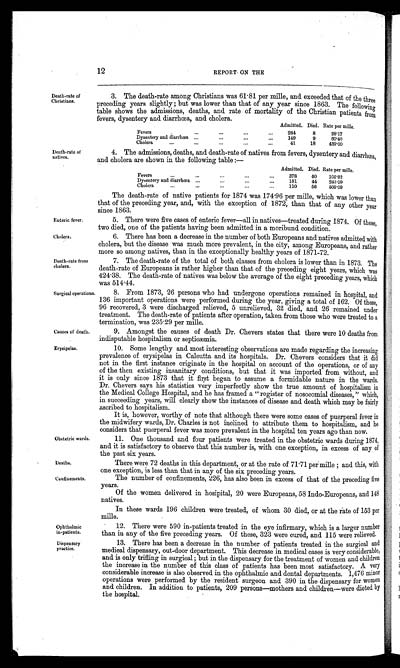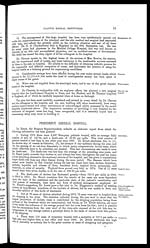Medicine - Institutions > Reports from medical colleges, schools and research institutions > Report on the Calcutta medical institutions > Calcutta medical institutions reports 1871-78 > Report on the Calcutta Medical Institutions for the year 1874
(441) Page 12
Download files
Individual page:
Thumbnail gallery: Grid view | List view

12
REPORT ON THE
Death-rate of
Christians.
3. The death-rate among Christians was 61.81 per mille, and exceeded that of the three
preceding years slightly; but was lower than that of any year since 1863. The following
table shows the admissions, deaths, and rate of mortality of the Christian patients from
fevers,dysentery and diarrhœa, cholera.
| Admitted. | Died. | Rate per mills. | |||||
| Fevers | ... | ... | ... | ... | 284 | 8 | 28.17 |
| Dysentery and diarrhœa | ... | ... | ... | ... | 149 | 9 | 60.40 |
| Cholera | ... | ... | ... | ... | 41 | 18 | 439.00 |
Dath-rate of
natives.
4. The admissions, deaths, and death-rate of natives from fevers, dysentery and diarrhœa
and cholera are shown in the following table:—
| Admitted. | Died. | Rate per mille. | |||||
| Fevers | ... | ... | ... | ... | 378 | 40 | 105.82 |
| Dysentery and diarrhœa | ... | ... | ... | ... | 181 | 44 | 243.09 |
| Cholera | ... | ... | ... | ... | 110 | 56 | 509.09 |
The death-rate of native patients for 1874 was 174.96 per mille, which was lower than
that of the preceding year, and, with the exception of 1872, than that of any other year
since 1863.
Enteric fever.
5. There were five cases of enteric fever—all in natives—treated during 1874. Of these,
two died, one of the patients having been admitted in a moribund condition.
Cholera.
6. There has been a decrease in the number of both Europeans and natives admitted with
cholera, but the disease was much more prevalent, in the city, among Europeans, and rather
more so among natives, than in the exceptionally healthy years of 1871-72
Death-rate from
cholera.
7. The death-rate of the total of both classes from cholera is lower than in 1873 The
death-rate of Europeans is rather higher than that of the preceding eight years, which was
424.38. The death-rate of natives was below the average of the eight preceding years, which
was 514.44.
Surgical operations.
8. From 1873, 26 persons who had undergone operations remained in hospital, and
136 important operations were performed during the year, giving a total of 162. Of these,
96 recovered, 3 were discharged relieved, 5 unrelieved, 32 died, and 26 remained under
treatment. The death-rate of patients after operation, taken from those who were treated to a
termination, was 235.29 per mille.
Causes of death.
9. Amongst the causes of death Dr. Chevers states that there were 10 deaths from
indisputable hospitalism or septicæmia.
Erysipelas.
10. Some lengthy and most interesting observations are made regarding the increasing
prevalence of erysipelas in Calcutta and its hospitals. Dr. Chevers considers that it did
not in the first instance originate in the hospital on account of the operations, or of any
of the then existing insanitary conditions, but that it was imported from without, and
it is only since 1873 that it first began to assume a formidable nature in the wards.
Dr. Chevers says his statistics very imperfectly show the true amount of hospitalism in
the Medical College Hospital, and he has framed a "register of nosocomial diseases," which,
in succeeding years, will clearly show the instances of disease and death which may be fairly
ascribed to hospitalism.
It is, however, worthy of note that although there were some cases of puerperal fever in
the midwifery wards, Dr. Charles is not inclined to attribute them to hospitalism, and he
considers that puerperal fever was more prevalent in the hospital ten years ago than now.
Obstetric wards.
11. One thousand and four patients were treated in the obstetric wards during 1874,
and it is satisfactory to observe that this number is, with one exception, in excess of any of
the past six years.
Deaths.
There were 72 deaths in this department, or at the rate of 71.71 per mille; and this, with
one exception, is less than that in any of the six preceding years.
Confinements.
The number of confinements, 226, has also been in excess of that of the preceding five
years.
Of the women delivered in hosipital, 20 were Europeans, 58 Indo-Europeans, and 148
natives.
In these wards 196 children were treated, of whom 30 died, or at the rate of 153 per
mille.
ophthalmic
in-patients.
12. There were 590 in-patients treated in the eye infirmary, which is a larger number
than in any of the five preceding years. Of these, 323 were cured, and 115 were relieved.
Dispensary
practice.
13. There has been a decrease in the number of patients treated in the surgical and
medical dispensary, out-door department. This decrease in medical cases is very considerable,
and is only trifling in surgical; but in the dispensary for the treatment of women and children
the increase in the number of this class of patients has been most satisfactory. A very
considerable increase is also observed in the ophthalmic and dental departments. 1,476 minor
operations were performed by the resident surgeon and 390 in the dispensary for women
and children. In addition to patients, 209 persons—mothers and children—were dieted by
the hospital.
Set display mode to: Large image | Zoom image | Transcription
Images and transcriptions on this page, including medium image downloads, may be used under the Creative Commons Attribution 4.0 International Licence unless otherwise stated. ![]()
| Permanent URL | https://digital.nls.uk/74974211 |
|---|
| Description | 13 titles. Describes research work and conditions, treatments, vaccine production, medical education, public health and disease outbreaks. Extensive tables show mortality rates and patient admissions. These - some from asylums, jails, dispensaries, civil and police hospitals – will be useful to epidemiologists. |
|---|




